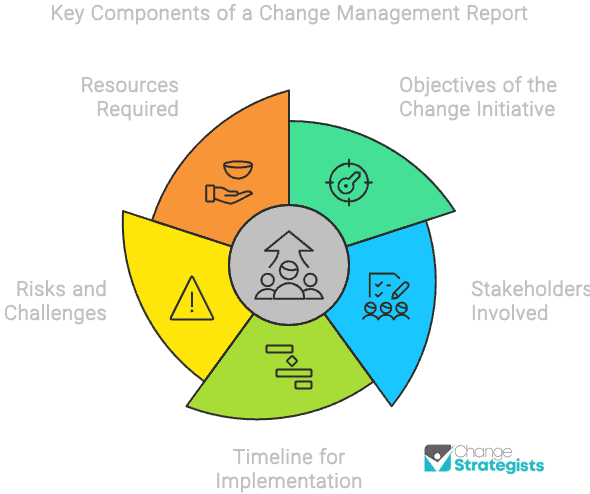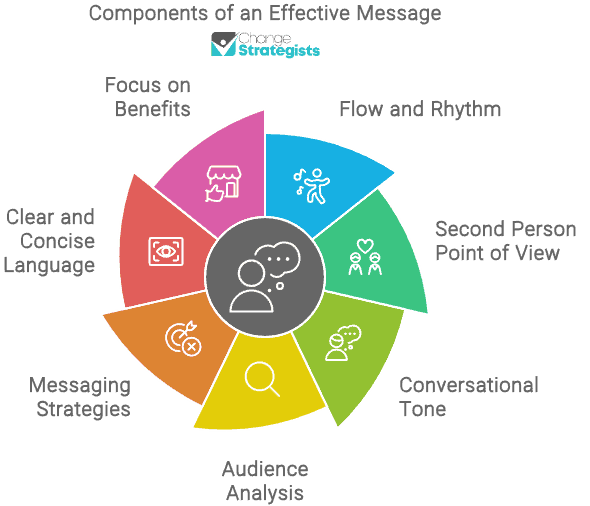Are you ready to lead your team through a major change, but unsure of how to effectively communicate and implement it? Writing a change management report can be a daunting task, but it is a crucial step in ensuring a smooth transition and achieving desired outcomes.
It is like charting a course before embarking on a journey – without a well-planned strategy, you may encounter unexpected obstacles and lose your way. In this article, we will guide you through the process of creating a comprehensive change management report that will help you identify potential roadblocks, address stakeholder concerns, and successfully navigate your team towards a brighter future.
To write a change management report, it’s important to follow a structured approach. Start by identifying the need for change, then analyze the impact of the change on the organization and its stakeholders. Develop a plan for implementing the change, including timelines, resources required, and potential risks. Finally, communicate the change to all stakeholders and provide regular updates on its progress. Make sure to include data and metrics that demonstrate the success of the change.
A change management report outlines the proposed changes, assesses their impact, and provides a roadmap for implementation. It is not only a tool for communication but also a means for building consensus and addressing resistance.
By creating a well-crafted report, you can gain buy-in from stakeholders, manage expectations, and mitigate risks. Whether you are introducing a new system, restructuring your organization, or launching a new product, a change management report is an essential component of your strategy.
So, take a deep breath and let’s get started on the journey towards a successful change management report.
Understanding the Purpose and Importance of a Change Management Report
Understanding the significance and purpose of a document detailing modifications to an organization’s procedures and operations can aid in the smooth transition of the implemented changes. This is where a change management report comes in. It is a document that outlines the changes that are going to take place within a company, including the reasons for the changes, the expected outcomes, and the steps that will be taken to ensure that the changes are successful.
The importance of a change management report cannot be overstated. It’s a crucial tool that helps managers and employees understand the changes that are taking place and what’s expected of them. It provides a roadmap for the implementation of the changes, ensuring that everyone is on the same page and working towards the same goals.

By having a clear understanding of the changes, employees are more likely to embrace them and work towards their successful implementation.
The benefits of a change management report extend beyond the initial implementation of the changes. It provides a record of what changes were made and why, which can be useful in the future. It can also help to identify areas where further improvements can be made, and can serve as a reference for future change management efforts.
In short, a change management report is a vital tool for any organization that wants to manage change effectively and achieve its goals.
Defining the Scope of the Report
Let’s delve into the scope of this document and explore the areas we’ll be addressing. Defining the scope is a critical aspect of writing a change management report. It involves identifying the key components that need to be included and determining the necessary information required to support the change process.
The scope of the report should be clearly defined to avoid ambiguity and ensure that all stakeholders have a clear understanding of what will be covered. The scope should also be limited to what’s relevant to the change initiative. This helps to keep the report concise, focused, and relevant.
The key components that should be included in the scope of the report are:
- The objectives of the change initiative
- The stakeholders involved
- The timeline for implementation
- The risks and challenges associated with the change
- The resources required to support the change process.
To define the scope of the change management report, it’s important to gather input from all relevant stakeholders. This helps in ensuring that the report captures all the necessary information required to support the change process. Additionally, it’s important to consider the audience for the report. The scope should be tailored to meet the needs of the target audience and provide them with the information they need to make informed decisions about the change initiative.
By defining the scope of the report, you can ensure that the report is comprehensive, focused, and relevant to the change initiative.
Conducting a Stakeholder Analysis
You need to conduct a stakeholder analysis to identify the individuals or groups who’ll be impacted by the proposed changes and to understand their opinions, concerns, and potential resistance. This step is crucial because it allows you to tailor your change management plan to meet the needs of each stakeholder group.
Identifying stakeholders early on in the process will also help you anticipate potential roadblocks and develop strategies to overcome them. To conduct a stakeholder analysis, start by creating a list of all the individuals and groups who might be affected by the changes. This includes employees, customers, suppliers, partners, and anyone else who has a stake in the success of your organization.

Once you have your list, prioritize the stakeholders based on the level of impact they’ll experience and their level of influence over the change. This will help you determine the best approach for engaging with each stakeholder group. When conducting the analysis, be sure to gather as much information as possible about each stakeholder group.
This can include their needs, concerns, and expectations, as well as any potential resistance they may have to the proposed changes. By taking the time to understand each stakeholder group and their unique perspectives, you can create a change management plan that’s tailored to their needs and more likely to be successful.
Communicating the Proposed Change
When communicating the proposed change, it’s important to craft an effective message that’s clear, concise, and consistent. This involves understanding the audience and tailoring the message to their needs and concerns.
Additionally, selecting the appropriate communication channels is crucial to ensure the message reaches the intended audience in a timely and effective manner.
Remember to keep these key points in mind when communicating your proposed change to stakeholders.
Crafting an Effective Message
Crafting an effective message involves creating a flow and rhythm that engages the reader with a second person point of view and contractions. By using a conversational tone, you can grab the reader’s attention and keep them interested in what you have to say.

Messaging strategies play a crucial role in crafting an effective message. Knowing your audience and understanding their needs and preferences will help you tailor your message to resonate with them. Audience analysis is an essential step in crafting an effective message. You need to understand their perspective, their challenges, and their motivations to create a message that resonates with them.
Once you have a clear understanding of your audience, you can use messaging strategies that best suit them. When crafting your message, make sure to use clear and concise language. Avoid using jargon or technical terms that may confuse your audience.
Finally, always remember to keep your message focused on the benefits of the proposed change and how it will help your audience.
Selecting the Appropriate Communication Channels
Navigating the sea of communication channels can be overwhelming, but fear not, as we’re on a journey to discover the most suitable channels for conveying your message effectively.
Selecting the appropriate channels for your change management report is crucial in ensuring that your message is heard and understood by your audience. Here are some Dos and Don’ts to keep in mind when choosing the channels to use:
-
DO tailor your communication channels to your audience. Consider their preferences and habits when it comes to consuming information.
-
DON’T rely solely on one channel. Use a mix of channels to reach a wider audience and increase the chances of your message being received.
-
DO test your channels beforehand. Ensure that your message is easily accessible and can be easily understood through the channels you have selected.
It is also important to understand that tailored communication is key to selecting the appropriate channels. Not all channels are suitable for all types of messages or audiences. By taking the time to analyze your audience and their needs, you can make informed decisions on the channels to use. This ensures that your change management report is received and acted upon by those who need it most.
Assessing the Impact of the Proposed Change
Assessing the impact of the proposed changes is a crucial step in determining the potential consequences and benefits that the organization may face. This involves conducting a comprehensive risk analysis which identifies the potential risks and challenges that may arise from implementing the change. By assessing the impact of the proposed change, you can determine if the benefits outweigh the risks and make informed decisions about the best course of action.
The first step in assessing the impact of the proposed change is to identify the stakeholders who will be affected by the change. This includes employees, customers, suppliers, and shareholders. It’s important to understand how the change will impact each stakeholder group and to identify any potential resistance or barriers to implementation.
This information can then be used to develop a plan to address any concerns and ensure a smooth transition.
Once the stakeholders and potential risks have been identified, it’s important to develop a mitigation plan to address any potential negative impacts. This plan should include strategies to minimize any disruption to operations and to ensure that employees are fully trained and prepared for the change.
By taking a proactive approach to assessing the impact of the proposed change, you can minimize the risks and ensure a successful implementation.
Developing a Detailed Implementation Plan
Get ready to take action and make your vision a reality with a detailed plan to implement your strategy. Developing a detailed implementation plan is crucial in ensuring the success of your change initiative.
This plan should include timelines for each step of the implementation process and a clear allocation of resources. Creating timelines is a critical component of your implementation plan. Timelines ensure that each step of the process is completed in a timely manner, and deadlines are met.
It is important to be realistic when creating your timelines, taking into account any potential setbacks and unexpected delays. By doing so, you can avoid rushing the process and ensure that each step is completed thoroughly.
Allocating resources is another important aspect of your implementation plan. This includes assigning the necessary personnel to complete each step, as well as any financial or material resources required. By allocating resources efficiently, you can ensure that each step is completed successfully and within budget.
A detailed plan for resource allocation also helps to identify any potential gaps or areas of concern that need to be addressed before implementation begins. In summary, developing a detailed implementation plan is crucial to the success of your change initiative.
By creating timelines and allocating resources, you can ensure that each step of the process is completed efficiently and effectively. Remember to be realistic when developing your plan and to remain flexible in the face of unexpected setbacks.
Addressing Resistance to Change
Don’t let resistance stand in the way of progress – learn how to address it head-on in the next section. Overcoming resistance is crucial in implementing changes successfully.
Resistance is a natural reaction to change, and it can come from anywhere: employees, stakeholders, or even customers. Addressing it is key to ensuring that the change management plan is executed smoothly.
Change communication strategies are a great way to tackle resistance. Communication is key to making sure that everyone is on the same page. When implementing a change, it’s important to communicate not only the change itself but also the reasons behind it. Providing a clear understanding of the change and why it’s necessary can help alleviate any concerns and resistance that may arise.
Incorporating feedback is another way to address resistance. During the implementation process, it’s important to gather feedback from all stakeholders. This feedback can help identify any potential issues and concerns that may arise and can help address them quickly. By addressing issues and concerns in a timely manner, it’s possible to overcome resistance and ensure that the change management plan is executed successfully.
Monitoring and Evaluating the Change
As you begin to implement a change, it’s important to define metrics for success so that you know what you’re aiming for. This will help you determine whether the change has been successful or not.
Once you have defined these metrics, it’s also important to establish a system for monitoring progress so that you can track how well the change is going and make adjustments as needed.
Defining Metrics for Success
Defining metrics that’ll measure the success of the implemented changes is crucial, as it allows you to measure the effectiveness of your change management plan. Without metrics, it’d be difficult to track progress and understand whether the changes made are making a positive impact.
By defining metrics, you can identify the key performance indicators (KPIs) that’ll help you evaluate the effectiveness of your plan. To define metrics, start by identifying the goals of the change management plan. What’re the desired outcomes? What do you want to achieve?
Once you’ve identified the goals, you can determine the KPIs that’ll help measure progress towards those goals. Some common KPIs include increased revenue, improved customer satisfaction, decreased turnaround time, and reduced costs.
By defining metrics, you can ensure that your change management plan is moving in the right direction and achieving the desired outcomes.
Establishing a System for Monitoring Progress
Establishing a system to monitor progress is essential. It ensures that the implemented changes are moving in the right direction and achieving the desired outcomes. Tracking progress helps you identify if the changes are improving or worsening the situation. Without a system in place, it’s difficult to measure success and make informed decisions moving forward.
When designing a system for monitoring progress, it’s important to define what metrics to track and how to collect data. Consider using both quantitative and qualitative data to get a comprehensive understanding of the situation.
Also, establish a regular reporting schedule to keep everyone informed and accountable for the progress of the changes. With a reliable system for tracking progress, you can make data-driven decisions and adjust the changes as needed to ensure success.
Reviewing and Revising the Report
As you’re reviewing and revising your change management report, it’s important to seek feedback from key stakeholders. This can help ensure that your report accurately reflects their perspectives and needs. Incorporating their revisions can also increase the effectiveness of your report and strengthen the likelihood of successful change implementation.
Take the time to review and revise your report with the input of others. This can be a valuable opportunity to gather diverse perspectives and improve the overall quality of your report. So, don’t be afraid to solicit feedback and make necessary adjustments.
Remember, the success of your change management efforts depends on the quality and accuracy of your report. By working collaboratively with others and taking their feedback into account, you can increase the chances of a successful outcome.
Seeking Feedback from Key Stakeholders
Get input from influential parties involved in the transition process by actively seeking out their thoughts on the matter and incorporating their feedback in the plan.
These stakeholders can provide valuable insight and help identify potential roadblocks that may not have been considered previously. Gathering input can be done in a variety of ways, such as holding focus groups, sending out surveys, or conducting one-on-one interviews.
Once you’ve gathered input, it’s essential to analyze the responses and identify common themes or concerns. This will help you tailor the change management plan to address these issues and ensure that the transition process is as smooth as possible.
Make sure to keep an open mind when reviewing feedback, as it may challenge assumptions or preconceived notions about the project. By seeking feedback from key stakeholders and incorporating their input, you can increase the chances of success and minimize resistance to change.
Incorporating Feedback and Revisions
Now that you’ve sought feedback from key stakeholders, it’s time to incorporate their suggestions and revise your change management report accordingly. Effective feedback is crucial in ensuring that your report is comprehensive and reflective of the needs and perspectives of all stakeholders involved.
It’s important to take note of all the feedback provided, whether positive or negative, and to consider each one carefully before making any revisions. The revision process can be overwhelming, but it’s important to stay organized and prioritize the feedback that will have the most impact on the report.
Start with the most critical and relevant feedback first, and work your way down to the less important ones. Make sure to keep track of the revisions you make, and review your changes to ensure that they align with the overall objectives of your report.
Remember that the ultimate goal of incorporating feedback is to improve the quality and effectiveness of your change management report.
Finalizing and Presenting the Change Management Report
It’s time to wrap up and showcase the fruits of our labor with a final presentation that will blow everyone away. After all the feedback and revisions, it’s important to take a step back and look at the big picture.
Start by reviewing the report structure and making sure all the necessary components are in place. This includes a clear executive summary, detailed analysis, and action plan for moving forward. Double-check formatting, typos, and grammatical errors to ensure a polished final product.
When it comes to presenting the report, there are a few tips to keep in mind. First, practice ahead of time to ensure a smooth delivery and timing. Make sure to speak clearly and confidently, using visual aids to enhance the presentation. Keep the audience engaged by asking questions and encouraging participation.
Lastly, be prepared to answer any questions or concerns that may arise. After all the hard work, it’s time to present the change management report. Remember that this is your chance to showcase the success of the project and the value of the changes made.
Be confident and proud of what you and your team have accomplished. By following these tips and presenting a polished report, you’re sure to impress the audience and leave a lasting impression.
What Should Be Included in a Change Management Report for Rolling Out Change Management?
When rolling out change management, a comprehensive change management report should include a clear vision for the change, detailed implementation plan, communication strategy, stakeholder analysis, and risk management plan. It is essential to track progress and measure the impact of rolling out change management to ensure successful implementation.
Conclusion
Congratulations! You’ve successfully completed your change management report. It’s time to present your findings to your stakeholders and implement the proposed changes.
Remember, as the saying goes, ‘Rome wasn’t built in a day.’ Change takes time and effort, so be patient and persistent. Be prepared to face challenges along the way, but don’t let them discourage you.
Keep an open mind and be flexible, ready to adapt and revise your plan as needed. Remember that change management is an ongoing process, so monitor and evaluate the changes to ensure they’re achieving the desired outcomes.
Your hard work and dedication will pay off in the end. By effectively managing change, you can improve organizational performance and achieve your goals. Good luck on your journey, and don’t forget to celebrate your successes along the way!





